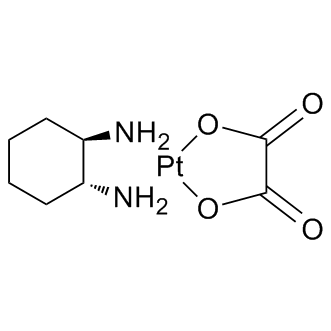| Cas No.: | 61825-94-3 |
| SMILES: | O=C(O[Pt]O1)C1=O.N[C@H]2[C@H](N)CCCC2 |
| Formula: | C8H14N2O4Pt |
| M.Wt: | 397.3 |
| Sotrage: | 2 years -20°C Powder, 2 weeks 4°C in DMSO, 6 months -80°C in DMSO |
| Description: | Oxaliplatin is a DNA synthesis inhibitor. It causes DNA crosslinking damage, prevents DNA replication and transcription and causes cell death. |
| In Vivo: | Oxaliplatin (10 mg/kg, i.p.) significantly reduces tumor volume and apoptotic index in the nude mice bearing hepatocellular HCCLM3 tumors[4]. Oxaliplatin (5 mg/kg, i.v.) is effective on T-leukemia-lymphoma L40 AKR with T/C of 1.77. Oxaliplatin is efficient on intracerebrally grafted L1210 leukemia, MA 16-C xenografts, B16 melanoma xenografts, Lewis lung xenografts and C26 colon carcinoma xenografts[5]. Oxaliplatin induces impairment of retrograde neuronal transport in mice[6]. |
| In Vitro: | Oxaliplatin acts through the formation of DNA-adducts. Oxaliplatin induces primary and secondary DNA lesions leading to cell apoptosis[1]. Oxaliplatin inhibits human melanoma cell lines C32 and G361 with IC50 values of 0.98 mM and 0.14 mM, respectively[2]. Oxaliplatin potently inhibits bladder carcinoma cell lines RT4 and TCCSUP, ovarian carcinoma cell line A2780, colon carcinoma cell line HT-29, glioblastoma cell lines U-373MG and U-87MG, and melanoma cell lines SK-MEL-2 and HT-144 with IC50 of 11 μM, 15 μM, 0.17 μM, 0.97 μM, 2.95 μM, 17.6 μM, 30.9 μM and 7.85 μM, respectively[3]. |

 DC Chemicals' products qualify for U.S. tariff exemptions. We guarantee no price increases due to customs duties and maintain stable supply, continuing to deliver reliable research solutions to our American clients.
DC Chemicals' products qualify for U.S. tariff exemptions. We guarantee no price increases due to customs duties and maintain stable supply, continuing to deliver reliable research solutions to our American clients.





















